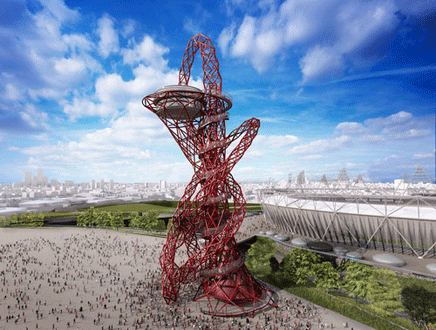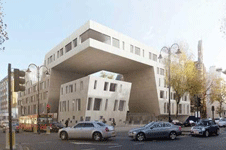Kingston student asks: Is it sculpture, architecture or sculptecture?

With designs for the Olympic logo, mascot and stadium all attracting heavy criticism from both the media and public, it is perhaps not surprising that the latest addition to the programme for London 2012 should also come under fire.
The ArcelorMittal Orbit tower has been designed by Turner prize-winning artist Anish Kapoor with the estimated ôÈ18m cost being largely underwritten by Lakshmi Mittal, the richest man in Europe with the worldãs largest steel company and a personal wealth estimated at more than ôÈ19bn.
Suggestions that the design is impressive as a feat of engineering yet potentially less successful as sculpture may have resulted from the need to include lifts and a visitor viewing platform to appease the judging panel set by London mayor Boris Johnson
Steel has featured before in Kapoors work, most notably his 2002 work Marsyas, a series of huge steel rings joined by a single span of deep red PVC membrane and designed specifically for the Turbine Hall at Tate Modern. Like the AcelorMittal tower, the project was constructed in collaboration with Cecil Balmond and his team at Arup.
The respective roles of Kapoor and Balmond on the Olympic tower, as artist and engineer respectively, are worth considering.
Suggestions that the design is impressive as a feat of engineering yet potentially less successful as sculpture may have resulted from the need to include lifts and a visitor viewing platform to appease the judging panel set by London mayor Boris Johnson.
It is possible that these structural considerations may have compromised some of the fluidity of Kapoors style as seen in his previous works. One of the undoubted highlights of the artists 2009 show at the Royal Academy was his piece Shooting into the Corner, which fired red wax from a cannon. It is a shame that the concept could not have been reworked for the Olympics, perhaps mimicking the starting pistol inside the stadium and firing huge wax balls into the sky over London at the start of the 100m.
Recent findings from CABE suggest that the designs for several elements of the Orbit tower may have been rushed through, raising serious questions about the planning of the project and its proposed construction timetable. With a clear and non-transferable deadline ahead of them it is hoped that Kapoor and Balmond can provide answers to the slightly mundane questions asked regarding waste disposal and power supply issues.
Johnsons claim that the structure will be considered as Londonãs answer to the Eiffel Tower have not dampened the sense of humour surrounding the project. Let us hope that the completed tower will become a genuine iconic London landmark rather than a reminder of period when governmental judgement on design and architecture was based on budgetary concerns rather than aesthetic.
Pete Collard is completing a masters degree in Curating Contemporary Design at and the .
Source
If you would like to take part in First Impressions email nargess@me.com..



























No comments yet